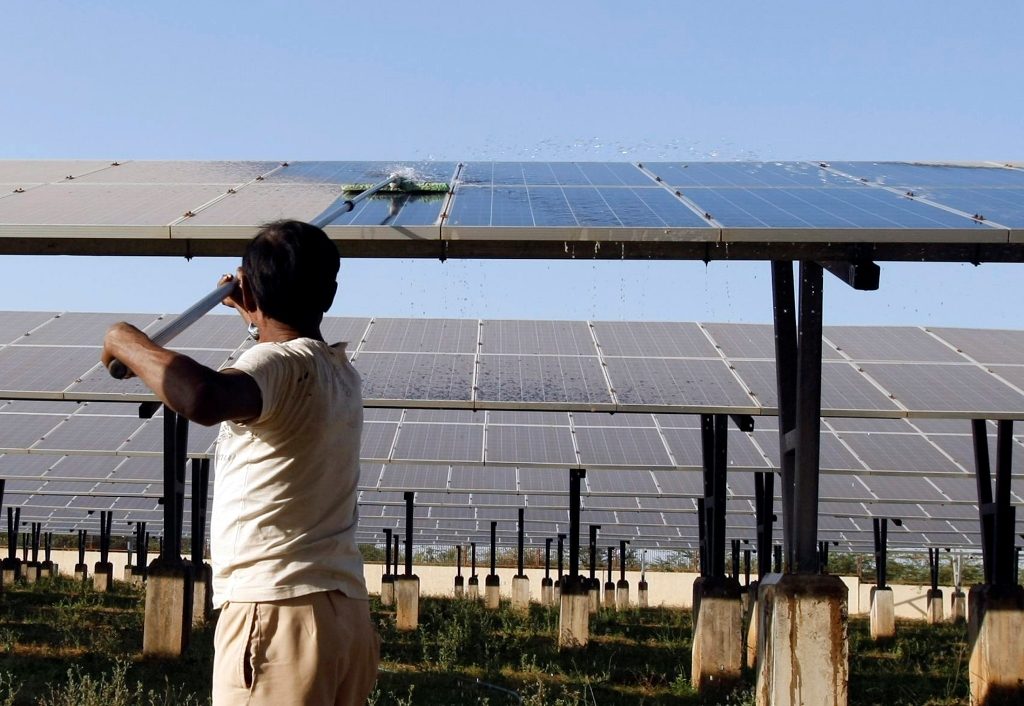
Prime Minister Narendra Modi needs at least $100 billion more to finance India’s goals for clean energy even after his government’s policies brought in record investment in wind and solar power stations.
That’s the conclusion of a report by Bloomberg New Energy Finance, which found $10.5 billion flew into renewables in India for the fiscal year ended March 31, almost 60 percent more than the $6.6 billion invested two years ago. It also said 7.3 gigawatts of clean-energy projects were built for the latest fiscal year, which is 71 percent higher than the previous period.
The findings represent the broadest assessment yet of the money going into India’s clean-energy industry. Growth in the renewables business has helped India become the third-biggest power market in the world after China and the U.S., according to the BNEF report. Modi has set a goal of building 175 gigawatts of clean-energy capacity by 2022 to supply more of the 62 million households that lack access to reliable grids and feed demand for electricity that’s projected to rise fourfold by 2040.
“He’s taking the right steps, but the targets are quite ambitious,” said Shantanu Jaiswal, the lead author of the report at BNEF. “The question is where do people get the money — $100 billion is a lot of money for this industry, especially given where we’re starting from.”
An investment of $100 billion is equivalent to almost 5 percent of all the goods and services produced annually by the nation of 1.3 billion people, according to data compiled by Bloomberg.
Diversified Financing
The report, sponsored by the David and Lucile Packard Foundation, a U.S. non-profit working to mitigate climate change with renewable energy, was released at BNEF’s conference in Shanghai on Tuesday. It also found that India has installed clean-energy capacity of 42.6 gigawatts. That accounts for 14 percent of the nation’s total generation capacity, up from 12.5 percent three years ago.
Jaiswal said the nation needs to diversify its sources of finances to reach the goal, bringing in big international banks to complement the lending done by India’s state-backed institutions and the development banks active in the country. It also needs to reduce the cost of debt financing for solar projects, which is more than double the rate charged in China and six times interest rates available in Japan, according to the report.
State Bank of India and Punjab National Bank, along with Axis Bank Ltd. and Yes Bank Ltd., have helped supply much of the finance along with non-bank lenders such as Tata Cleantech Capital Ltd. and L&T Finance Ltd. Development institutions include the Indian Renewable Energy Development Agency, the World Bank’s International Finance Corp., the Asian Development Bank and KFW of Germany.
The huge capital needed to meet the targets, as well as the high cost of capital, mean that fundraising from the public markets will be critically important, according to the report. Along with green bonds, India is turning to infrastructure investment trusts, which are used to free up and recycle developers’ capital stuck in operational projects by securitizing the revenue streams and offering the units on the public market.
The arrangement, expected to help the inflow of foreign capital and reduce the exposure of domestic financial institutions, was approved in September 2014 by the Securities and Exchange Board of India.
Infrastructure investment trusts are similar to yieldcos in helping developers combine multiple projects.
To create safeguards for investors in infrastructure investment trusts, regulators have set a requirement for a minimum number of independent directors in the investment management firm and have also placed restrictions on transactions done between related parties, according to the report.
India also needs to improve on the management of power distribution companies, according to BNEF’s Jaiswal.
“Right now, India’s power distribution utilities are in huge debts, so they don’t buy power even when there’s demand,” Jaiswal said.
Retailers held total debt of almost 4.1 trillion rupees ($60 billion) at the end of March 2015, Power Minister Piyush Goyal said in August. That leaves the country’s power plants running below capacity, while one in five people go without electricity.